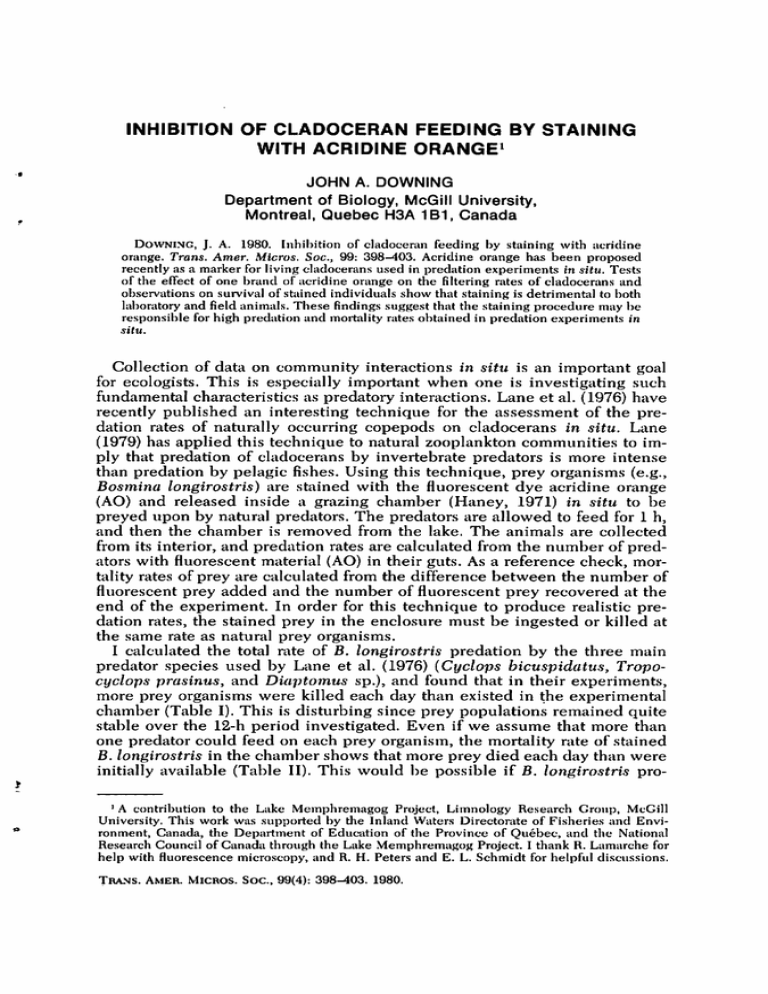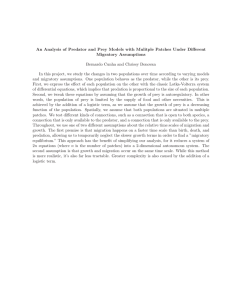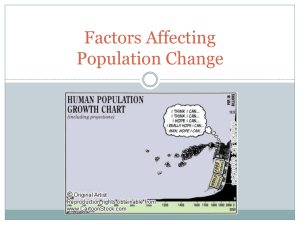INHIBITION OF CLADOCERAN FEEDING BY STAINING WITH ACRIDINE ORANGE1 JOHN A. DOWNING
advertisement

INHIBITION OF CLADOCERAN FEEDING BY STAINING WITH ACRIDINE ORANGE1 JOHN A. DOWNING Department of Biology, McGill University, Montreal, Quebec H3A 1B1, Canada Downing, J. A. 1980. Inhibition of cladoceran feeding by staining with acridine orange. Trans. Amer. Micros. Soc, 99: 398-403. Acridine orange has been proposed recently as a marker for living cladocerans used in predation experiments in situ. Tests of the effect of one brand of acridine orange on the filtering rates of cladocerans and observations on survival of stained individuals show that staining is detrimental to both laboratory and field animals. These findings suggest that the staining procedure may be responsible for high predation and mortality rates obtained in predation experiments in situ. Collection of data on community interactions in situ is an important goal for ecologists. This is especially important when one is investigating such fundamental characteristics as predatory interactions. Lane et al. (1976) have recently published an interesting technique for the assessment of the pre dation rates of naturally occurring copepods on cladocerans in situ. Lane (1979) has applied this technique to natural zooplankton communities to im ply that predation of cladocerans by invertebrate predators is more intense than predation by pelagic fishes. Using this technique, prey organisms (e.g., Bosmina longirostris) are stained with the fluorescent dye acridine orange (AO) and released inside a grazing chamber (Haney, 1971) in situ to be preyed upon by natural predators. The predators are allowed to feed for 1 h, and then the chamber is removed from the lake. The animals are collected from its interior, and predation rates are calculated from the number of pred ators with fluorescent material (AO) in their guts. As a reference check, mor tality rates of prey are calculated from the difference between the number of fluorescent prey added and the number of fluorescent prey recovered at the end of the experiment. In order for this technique to produce realistic pre dation rates, the stained prey in the enclosure must be ingested or killed at the same rate as natural prey organisms. I calculated the total rate of B. longirostris predation by the three main predator species used by Lane et al. (1976) (Cyclops bicuspidatus, Tropocyclops prasinus, and Diaptomus sp.), and found that in their experiments, more prey organisms were killed each day than existed in the experimental chamber (Table I). This is disturbing since prey populations remained quite stable over the 12-h period investigated. Even if we assume that more than one predator could feed on each prey organism, the mortality rate of stained B. longirostris in the chamber shows that more prey died each day than were initially available (Table II). This would be possible if B. longirostris pro1 A contribution to the Lake Memphremagog Project, Limnology Research Group, McGill University. This work was supported by the Inland Waters Directorate of Fisheries and Envi ronment, Canada, the Department of Education of the Province of Quebec, and the National Research Council of Canada through the Lake Memphremagog Project. I thank R. Lamarche for help with fluorescence microscopy, and R. H. Peters and E. L. Schmidt for helpful discussions. Trans. Amer. Micros. Soc, 99(4): 398^03. 1980. 399 DOWNING—INHIBITION OF CLADOCERAN FEEDING TABLE I1 Comparison of specific and total predation rates with prey concentrations in in situ experiments performed by Lane et al. (1976) 5m, 1200h 5m, 2400h 20m, 1200h 20m, 2400h Specific daily predation rate (PCl) Tropocyclops Cyclops Diaptomus 23 91 — 123 164 82 Total daily predation rate (Pc) 114 367 187 421 Bosmina (prey) concentration 19 23 11 17 Turnover time for stable Bosmina population (h) 4.0 157 23 7 259 162 1.5 — 1.4 1.0 1 The specific daily predation rates on Bosmina longirostris (PC1) weTe obtained by multiplying the daily predation rate per predator by the predator densities (D, + Dn) in table II and V of Lane et al. (1976). Pc is a summation of the Pt|. The concentrations of experimental prey were taken from table I of Lane etal. (1976). All densities and rates are expressed per 8.91. This table shows that if the predation rates are correct, then the population of B. longirostris would be required to reproduce its own biomass once every 1-4 h in order to maintain a stable population. duction rates were extremely high, but is unlikely because biomass turnover time should range from 0.10 to 0.25 days in order to maintain stable prey biomass. Biomass turnover times for unstained filter-feeding cladocerans range from 6.7 to 58.9 days in nature (Wetzel, 1975). It is clear then, that mortality rates of AO-stained B. longirostris in the experiments of Lane et al. (1976) were at least 25 times greater than those that could have been main tained by production rates. There are two possible circumstances that could lead to unnaturally high apparent mortality rates. The first of these arises from increased prey density in experimental chambers. The added prey were 2-5 times more abundant than the natural prey. It is well known that ingestion rates can increase mark edly with prey concentrations (Holling, 1965). The second possible cause of predation overestimation is that AO-labeled prey might have been captured more easily than other prey animals because of the staining procedure. The first circumstance seems unlikely since a 2-5-fold increase in prey concen tration would result in a relatively small increase in predation rate, unless the initial prey concentrations were very low. The second possibility was not tested by Lane et al. (1976), and could have resulted in considerable over- TABLE IP Comparison of the mortality rate of stained Bosmina longirostris with its population from in situ experiments performed by Lane et al. (1976). 5m, 1200h Number stained prey added Number stained prey remaining Stained prey killed/h Turnover time for stable Bosmina population (h) 20 16 4 5.0 5m, 2400h 20m, 1200h 20 20 12 8 8 2.5 12 1.7 20m, 2400h 20 9 11 1.8 1 The number of Buorescent prey remaining at the end of the experiment was obtained from table II of Lane et al. (1976). AH concentrations and rates are expressed per 8.91. This table shows that if the measured mortality rates mimic natural mortality rates, then B. longirostris must reproduce its population from 4 to 14 times per day to maintain a stable population. 400 TRANS. AMER. MICROS. SOC, VOL. 99, NO. 4, OCTOBER 1980 SIMOCEPHALUS VETULUS, LABORATORY 60• MEASURED IN STAIN o MEASURED AFTER RINSE 0 40 30 AO CONCENTRATION Fig. 1. 50 (ing/1) The effect of acridine orange stain (AO) on the filtering rate (v>, ml/animal/day ± 2 SE) of Simocephalus vetulus in laboratory experiments. AO decreased the filtering rate and the effect of AO remained after 30 min recovery time. estimation of predation rates if AO staining induced mortality or slowed prey movement. In developing a technique for measuring the uptake rate of periphyton by littoral cladocerans (Downing, 1981), I used AO as a marker for fresh animals added to chambers containing macrophytes labeled with 32P. I performed a series of experiments to assess the effect of AO staining on the behavior and filtering rate of a few cladoceran species. Materials and Methods Because I found that some Cladocera (Daphnia pulex, and Simocephalus vetulus) died after 30 min of exposure to low concentrations (14 mg/1) of AO, I performed laboratory experiments to determine the effects of short-term staining on their suspension feeding behavior. Ten large (—1.5 mm) S. vet ulus were transferred by Pasteur pipette from laboratory cultures to each of five 250-ml beakers of yeast suspension (Rhodotorula sp., 8 x 104 cells/ml in filtered dechlorinated tap water). Animals were allowed to feed normally for about 30 min following which time 103 cells/ml of radioactive (32P) Rhodo torula were added (Downing & Peters, 1980) and the concentration of AO (Fisher Scientific Co., A-971) in the beaker was raised to between 5 and 50 mg/1. Animals were allowed to feed in the radioactive stain solution for 5 min before they were anaesthetized with CO2 (Burns & Rigler, 1967), concen trated on a 102 /im mesh, and preserved with buffered sucrose-formalin so lution (Haney & Hall, 1973). Animals were transferred immediately to indi- DOWNING—INHIBITION OF CLADOCERAN FEEDING 401 SIDA CRYSTALLINA, IN SITU 100- • NATURAL o o STAINED Ld or « 50- o • • • •/• V/#o c LU o° o > 0 0.5 o o 41 BODY 1 1.5 LO LENGTH 2.0 (mm) FIG. 2. The effect of acridine orange (AO) on the filtering rate (VK, ml/animal/day) of Sida crystallina of various body lengths (anterior margin of head to posterior margin of carapace) in situ. AO staining, even at low concentrations, inhibits feeding. vidual planchettes and covered with Parafilm®. The ingested radioactivity was measured on a Geiger-Miiller counter under gas-flow. Filtering rates (VF), in ml/animal/day, were calculated (Rigler, 1971) as VF = R x 24/Rf x t where R is the radioactivity of one animal, Rf is the radioactivity of the food cells in 1 ml of the suspension, and t is the feeding time in hours. Another experiment was performed to determine if S. vetulus recovered from stain effects after removal from the stain solution. Ten animals were added to a yeast suspension as described above, but were stained (5 mg/1 AO), rinsed, and returned to a fresh yeast suspension before the filtering rate was measured with no further AO addition. Since I felt that natural and laboratory animals might respond differently to AO staining, I also tested the effect of staining on the filtering rates of cladocerans in situ. Littoral cladocerans on the surfaces of macrophytes were enclosed in a Plexiglas® chamber (Downing & Peters, 1980) in Lake Memphremagog (Ross & Kalff, 1975). Additional specimens were collected from an adjacent macrophyte, stained for 3 min with a low concentration of AO (0.83 mg/1), rinsed with fresh lakewater, and added to the Plexiglas® chamber. Radioactive yeast cells (Rhodotorula, <103 cells/ml) were added to the cham ber and the animals were allowed to feed for 13 min (a period less than gut clearance time). All animals were anaesthetized and removed from the cham ber and preserved as above. Stained animals were separated from the un stained animals using a Zeiss binocular dissecting microscope equipped with 402 TRANS. AMER. MICROS. SOC, VOL. 99, NO. 4, OCTOBER 1980 No. 44 barrier filters in the oculars. Illumination was supplied by a Zeiss HBO incandescent illuminator with a BG12 excitation filter. AO-stained animals could be distinguished from unstained animals by their bright yellowgreen fluorescence. Individuals of the most abundant species (Sida crystallina) were placed on planchettes, and filtering rates were measured and calculated as above. In earlier experiments (Downing, 1981), I found that han dling of the stained specimens had no effect on the feeding behavior of S. crystallina; thus, any difference in filtering rate observed between stained and unstained animals was a result of staining. Results and Discussion In the laboratory experiments, addition of AO decreased the filtering rate 10-fold in Simocephalus vetulus (Fig. 1). The effect of AO was somewhat less severe if the animals were removed from the AO solution, and then rinsed before the filtering rate was measured (open circle, Fig. 1). The swim ming behavior of S. vetulus also became erratic in high AO concentrations where the animals swam rapidly, often spinning in tight circles. In another laboratory experiment, I was able to obtain only slightly depressed filtering rates by staining for 30 min at 0.05 mg/1 AO. However, animals stained in this manner sometimes did not appear to be fluorescent. My field experiment shows that even brief staining at low AO concentration depressed the filtering rate of Sida crystallina significantly (Fig. 2). The an imals in this experiment were unable to feed normally, even though visual observations did not suggest altered behavior. They swam normally and had partially filled guts. If the Bosmina longirostris in Lane et al.'s (1976) experiments were af fected by AO in a similar manner, then the high mortality rates and high apparent predation rates could have been a result of decreased viability of the prey animals. Lane et al. (1976) stained their prey cladocerans for 3 min at 50 mg/1, a concentration high enough to inhibit feeding in Simocephalus vetulus and Sida crystallina (Figs. 1, 2). In fact, I observed that S. crystallina were killed after staining for 1 min at just 10 mg/1. If B. longirostris are influenced by AO, then they may be less able to avoid predators. They also might die from starvation or AO toxicity, and fall to the bottom of the feeding chamber becoming more readily ingestible (Lane et al., 1976). Thus, AO staining in these kinds of experiments might cause overestimation of preda tion rates, and also erroneous classification of detritus-feeding and scavenging copepods as predators. I believe that the in situ technique developed by Lane et al. (1976) should be applied with caution because of the toxicity of AO to cladocerans. When such a new technique is presented, it is important to demonstrate that pro cedures do not induce errors. Such a step is requisite to confidence in a measured variable as an accurate representation of the characteristic being studied. I did not use AO to stain cladocerans in subsequent experiments. Accordingly, I do not recommend that others use it, unless it can be dem onstrated that AO does not affect the behavior of the stained animals. Literature Cited BURNS, C. W. & Rigler, F. H. 1967. Comparison of filtering rates of Daphnia in lakewater and suspension of yeast. Limnol. Oceanogr., 12: 492-502. DOWNING—INHIBITION OF CLADOCERAN FEEDING 403 Downing, J. A. 1981. In situ foraging responses of three species of littoral Cladocera. Ecol. Monogr. (in press) Downing, J. A. & Peters, R. H. 1980. The effect of body size and food concentration on the in situ filtering rate of Sida crystallina. Limnol. Oceanogr., 25: 883-895. Haney, J. 1971. An in situ method for the measurement of zooplankton grazing rates. Limnol. Oceanogr., 16: 970-977. Haney, J. & Hall, D. J. 1973. Sugar-coated Daphnia: a preservation technique for Cladocera. Limnol. Oceanogr., 18: 331-333. HoLLING, C. S. 1965. The functional response of predators to prey density and its role in mimicry and population regulation. Mem. Entomol. Soc. Can., 45: 1-60. LANE, P. A. 1979. Vertebrate and invertebrate predation intensity on freshwater zooplankton communities. Nature, 280: 391-393. Lane, P. A., Klug, M. J. & Louden, L. 1976. Measuring invertebrate predation in situ on zooplankton assemblages. Trans. Amer. Micros. Soc, 95: 143-155. RlGLER, F. H. 1971. Feeding rates: zooplankton. In W. T. Edmondson & G. G. VVinberg, eds., Secondary productivity in fresh waters. IBP Handbook No. 17, Blackwell, Oxford, pp. 228-255. Ross, P. R. & Kalff, J. 1975. Phytoplankton production in Lake Memphremagog, Quebec (Canada)-Vermont (USA). Verb. Int. Verein. Limnol., 19: 760-769. Wetzel, R. G. 1975. Limnology. Saunders, Philadelphia. 743 pp.





